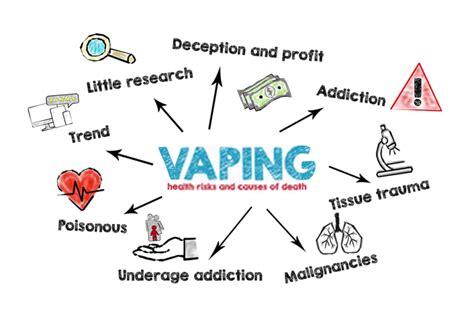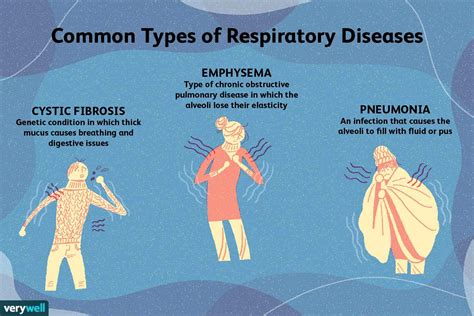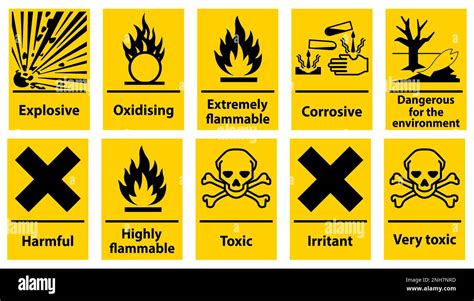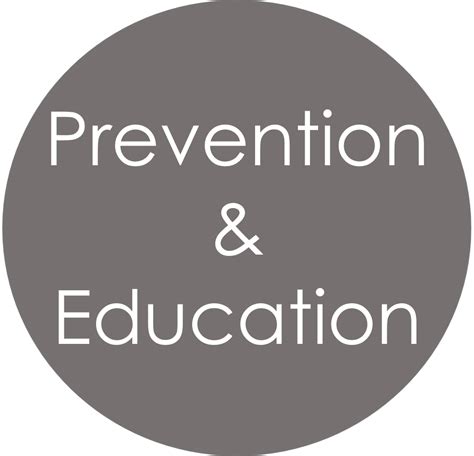Intro
Discover the 5 vaping risks, including nicotine addiction, respiratory issues, and lung damage, to understand the dangers of e-cigarettes and vaping devices, and learn how to mitigate vaping health risks and protect yourself from related hazards.
The vaping industry has experienced significant growth over the past decade, with many people turning to e-cigarettes as a perceived safer alternative to traditional tobacco products. However, a growing body of evidence suggests that vaping poses several health risks that should not be ignored. As the number of vaping-related illnesses and deaths continues to rise, it is essential to understand the potential dangers associated with vaping. In this article, we will delve into the world of vaping, exploring the risks and consequences of this increasingly popular habit.
The vaping phenomenon has been fueled by the widespread perception that e-cigarettes are a harmless way to consume nicotine. Many people, particularly youth and young adults, have been drawn to the appealing flavors and sleek designs of e-cigarettes, often unaware of the potential health risks. However, the reality is that vaping can have serious consequences, ranging from respiratory problems to nicotine addiction. As we navigate the complex world of vaping, it is crucial to separate fact from fiction and understand the risks involved.
The vaping industry has been shrouded in controversy, with many experts raising concerns about the lack of regulation and oversight. The absence of stringent regulations has allowed manufacturers to produce and market e-cigarettes with minimal scrutiny, often prioritizing profits over public health. As a result, the vaping market has become flooded with a vast array of products, many of which contain unknown or untested ingredients. This lack of transparency has made it challenging for consumers to make informed decisions about their health, highlighting the need for greater awareness and education about the risks associated with vaping.
Vaping Risks: An Overview

Vaping poses several health risks, including respiratory problems, nicotine addiction, and exposure to toxic chemicals. The aerosol produced by e-cigarettes can contain a range of harmful substances, including heavy metals, ultrafine particles, and volatile organic compounds. These substances can cause inflammation and damage to the lungs, leading to conditions such as bronchitis, asthma, and chronic obstructive pulmonary disease (COPD). Furthermore, the nicotine present in e-cigarettes can lead to addiction, particularly among youth and young adults, who are more susceptible to its effects.
Nicotine Addiction
Nicotine is a highly addictive substance that can have serious consequences for cardiovascular health. The nicotine present in e-cigarettes can increase heart rate and blood pressure, leading to an increased risk of heart attack, stroke, and other cardiovascular conditions. Additionally, nicotine can have negative effects on brain development, particularly in youth and young adults, who are more vulnerable to its effects. The developing brain is more susceptible to nicotine's addictive properties, which can lead to long-term cognitive and behavioral problems.Respiratory Problems

Vaping has been linked to a range of respiratory problems, including bronchitis, asthma, and COPD. The aerosol produced by e-cigarettes can contain a range of harmful substances, including particulate matter, heavy metals, and volatile organic compounds. These substances can cause inflammation and damage to the lungs, leading to respiratory problems and other health issues. Furthermore, the flavorings used in e-cigarettes can contain diacetyl, a chemical linked to a condition known as "popcorn lung," which can cause irreversible lung damage.
Popcorn Lung
Popcorn lung, also known as bronchiolitis obliterans, is a serious respiratory condition caused by the inhalation of diacetyl. This chemical is commonly used in e-cigarette flavorings, particularly in buttery or creamy flavors. The inhalation of diacetyl can cause inflammation and scarring in the lungs, leading to symptoms such as coughing, wheezing, and shortness of breath. In severe cases, popcorn lung can lead to respiratory failure, requiring lung transplantation or other intensive medical interventions.Toxic Chemicals

E-cigarettes can contain a range of toxic chemicals, including heavy metals, ultrafine particles, and volatile organic compounds. These substances can cause a range of health problems, including cancer, neurological damage, and reproductive issues. The absence of regulation and oversight has allowed manufacturers to produce and market e-cigarettes with minimal scrutiny, often prioritizing profits over public health. As a result, the vaping market has become flooded with a vast array of products, many of which contain unknown or untested ingredients.
Cancer Risk
The cancer risk associated with vaping is a significant concern, particularly among long-term users. The aerosol produced by e-cigarettes can contain a range of carcinogenic substances, including formaldehyde, acetaldehyde, and benzene. These substances can cause DNA damage and genetic mutations, leading to an increased risk of cancer. Furthermore, the nicotine present in e-cigarettes can increase the risk of cancer, particularly among people who are already at risk due to genetic or environmental factors.Vaping-Related Illnesses

Vaping-related illnesses have become a significant public health concern, with thousands of cases reported worldwide. The most common symptoms of vaping-related illnesses include respiratory problems, such as coughing, wheezing, and shortness of breath, as well as gastrointestinal symptoms, such as nausea, vomiting, and diarrhea. In severe cases, vaping-related illnesses can lead to respiratory failure, requiring intensive medical interventions, including mechanical ventilation and lung transplantation.
Outbreak Investigation
The outbreak investigation into vaping-related illnesses has been ongoing, with health officials working to identify the cause of the illnesses. The investigation has focused on the role of vitamin E acetate, a substance commonly used in THC-containing e-cigarettes. Vitamin E acetate has been linked to the development of lipoid pneumonia, a condition characterized by the accumulation of lipids in the lungs. The investigation has also highlighted the need for greater regulation and oversight of the vaping industry, particularly with regards to the use of unknown or untested ingredients.Prevention and Education

Prevention and education are key to reducing the risks associated with vaping. Public health campaigns have been launched to raise awareness about the dangers of vaping, particularly among youth and young adults. These campaigns have focused on the risks of nicotine addiction, respiratory problems, and exposure to toxic chemicals. Additionally, educational programs have been developed to provide people with the skills and knowledge they need to make informed decisions about their health.
Quitting Vaping
Quitting vaping can be challenging, particularly for people who are addicted to nicotine. However, there are several resources available to help people quit, including counseling, medication, and support groups. Nicotine replacement therapy (NRT) has been shown to be effective in reducing withdrawal symptoms and cravings, while medications such as bupropion and varenicline can help reduce the urge to vape. Additionally, support groups, such as Nicotine Anonymous, can provide people with a sense of community and connection, helping them to stay motivated and focused on their quit journey.Regulation and Oversight

Regulation and oversight are essential to reducing the risks associated with vaping. The absence of stringent regulations has allowed manufacturers to produce and market e-cigarettes with minimal scrutiny, often prioritizing profits over public health. However, there are signs that the regulatory landscape is changing, with many countries introducing new laws and regulations to govern the vaping industry. These regulations have focused on issues such as product safety, advertising, and youth access, highlighting the need for greater transparency and accountability in the vaping industry.
Future Directions
The future of vaping is uncertain, with many experts predicting that the industry will undergo significant changes in the coming years. The introduction of new regulations and laws will likely lead to a reduction in the number of vaping products available, as well as increased scrutiny of manufacturers and retailers. Additionally, the development of new technologies, such as nicotine-free e-cigarettes, may provide a safer alternative for people who want to quit smoking or reduce their nicotine intake.What are the risks associated with vaping?
+The risks associated with vaping include respiratory problems, nicotine addiction, and exposure to toxic chemicals. Vaping has been linked to a range of health problems, including bronchitis, asthma, and chronic obstructive pulmonary disease (COPD).
Can vaping cause cancer?
+The cancer risk associated with vaping is a significant concern, particularly among long-term users. The aerosol produced by e-cigarettes can contain a range of carcinogenic substances, including formaldehyde, acetaldehyde, and benzene.
How can I quit vaping?
+Quitting vaping can be challenging, but there are several resources available to help. These include counseling, medication, and support groups. Nicotine replacement therapy (NRT) and medications such as bupropion and varenicline can help reduce withdrawal symptoms and cravings.
In conclusion, the risks associated with vaping are significant and should not be ignored. As the vaping industry continues to evolve, it is essential to prioritize public health and safety above profits. By raising awareness about the dangers of vaping and promoting education and prevention, we can reduce the risks associated with this increasingly popular habit. We encourage readers to share their thoughts and experiences with vaping, and to take action to protect their health and well-being. Together, we can create a safer and healthier environment for everyone.
